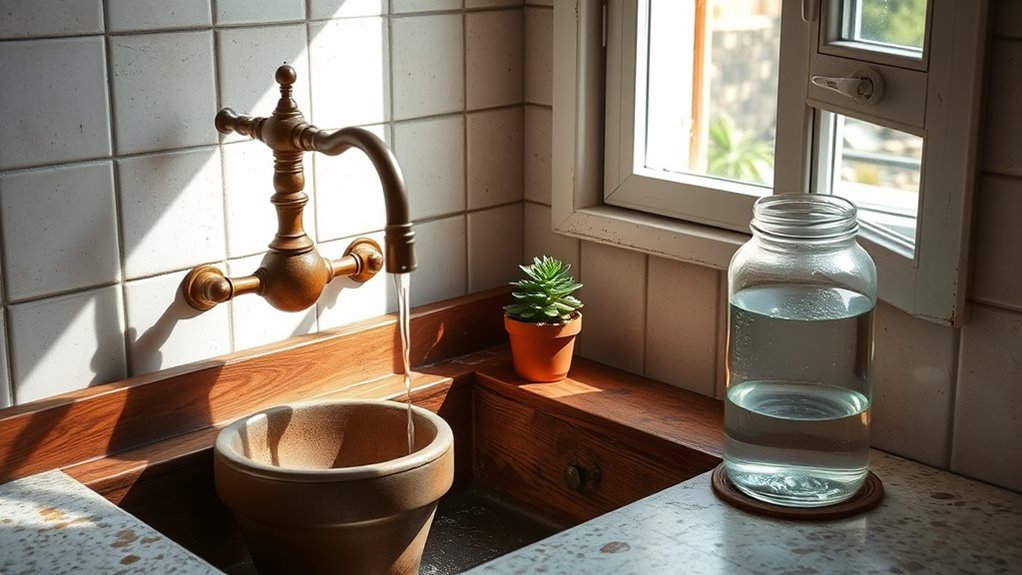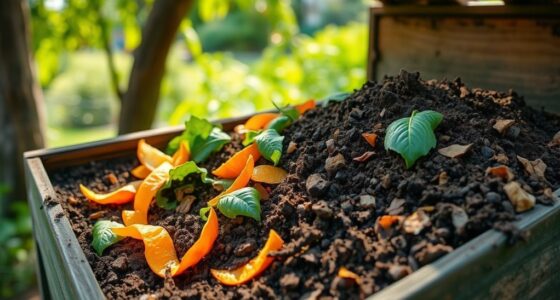To conserve water at home during Mediterranean droughts, you should install rainwater harvesting systems to reuse rainfall for outdoor and indoor needs. Upgrade to water-efficient appliances like low-flow toilets and eco-friendly dishwashers, and fix leaks promptly to prevent waste. Maintaining gutters and filters keeps the system working effectively. By adopting these strategies, you help reduce reliance on municipal water and enhance drought resilience—discover more ways to save water effectively.
Key Takeaways
- Install rainwater harvesting systems to reduce reliance on municipal water and manage stormwater runoff effectively.
- Upgrade to water-efficient appliances like low-flow toilets and high-efficiency dishwashers to minimize household water use.
- Regularly maintain gutters, filters, and tanks to ensure optimal rainwater collection and prevent issues like debris buildup.
- Fix leaks promptly and run appliances with full loads to prevent unnecessary water wastage.
- Adopt sustainable practices inspired by Mediterranean drought lessons to enhance household water resilience and conservation.

Water conservation in your home is essential for reducing your environmental impact and lowering utility bills. One effective way to do this is by implementing rainwater harvesting systems. Collecting rainwater from your roof isn’t just an eco-friendly choice; it’s a practical one that reduces reliance on municipal water supplies. You can use the stored rainwater for outdoor irrigation, flushing toilets, or even laundry, depending on how you set up your system. Installing gutters and downspouts that direct rainwater into barrels or tanks makes the process straightforward. Not only does this help conserve precious freshwater, but it also diminishes stormwater runoff that can cause erosion and pollution. To maximize benefits, ensure your rainwater harvesting system is properly maintained—clean gutters, filters, and tanks prevent debris and mosquito breeding. This simple addition to your home can considerably cut your water consumption, especially during drought conditions common in Mediterranean climates.
Alongside rainwater harvesting, focusing on appliance efficiency plays a key role in water conservation. Outdated dishwashers, washing machines, and toilets tend to waste more water than newer, energy-efficient models. Upgrading to high-efficiency appliances can dramatically reduce your household’s water footprint. For instance, modern dishwashers use about 3-4 gallons per load compared to older models that might use 10 gallons or more. Similarly, switching to low-flow toilets can save hundreds of gallons daily. When shopping for appliances, look for those with the WaterSense label, which certifies water efficiency without sacrificing performance. Regular maintenance is also essential—fix leaks promptly, and run full loads to maximize efficiency. These small but impactful adjustments help you conserve water without sacrificing comfort, which is especially critical during periods of drought or water restrictions.
Frequently Asked Questions
How Can I Detect Hidden Leaks in My Plumbing System?
To detect hidden leaks in your plumbing system, start with leak detection methods like monitoring your water meter for unusual activity when no fixtures are in use. Perform a pipe inspection by visually checking for damp spots or mold. Listen for hissing sounds or running water, and consider using a dye test or hiring a professional for more thorough leak detection. Regular maintenance helps prevent costly pipe damage and conserves water.
Are There Smart Devices to Monitor Household Water Usage Effectively?
Imagine your water usage as a heartbeat—steady, predictable, yet revealing. Smart water meters help you catch subtle changes, while usage monitoring apps serve as your personal health tracker. These devices alert you to leaks or excessive consumption, empowering you to take control. With this tech, you turn your home into a vigilant guardian, ensuring every drop counts and conserving water becomes effortless and intuitive.
What Are Eco-Friendly Landscaping Options to Reduce Water Needs?
You can choose native plants and implement xeriscaping techniques to reduce your water needs. Native plants thrive in your local climate, requiring less water, fertilizer, and maintenance. Xeriscaping involves designing your landscape with drought-tolerant plants, efficient irrigation, and minimal turf, which conserves water and lowers your bills. By combining these eco-friendly landscaping options, you create a beautiful, sustainable yard that withstands droughts and supports the environment.
How Does Water Conservation Impact My Home’s Energy Consumption?
Think of your home as a well-oiled machine; when you conserve water, you also reduce energy use. Less water heating is needed when you cut back on water consumption, lowering your energy bills. Using efficient appliances means less strain on your system, which saves both water and energy. By reducing water use, you’re directly impacting your home’s energy consumption, making your household more sustainable and cost-effective.
Can Greywater Recycling Be Safely Implemented in Residential Homes?
Yes, greywater recycling can be safely implemented in your home if you follow local greywater regulations. These regulations set guidelines to guarantee safe recycling, preventing health risks and environmental issues. You should install approved systems and avoid using greywater with hazardous substances like chemicals or pathogens. Properly maintaining your greywater system and staying compliant with regulations ensures safe recycling, saving water while protecting your family’s health and the environment.
Conclusion
By conserving water in your home, you protect your environment, preserve resources, and reduce costs. You save water, save energy, and save money. You become part of the solution, helping to combat droughts and safeguard future supplies. Every drop counts—every action matters. So, make small changes today, embrace mindful habits, and share your knowledge. Together, we can create a sustainable future, one mindful drop at a time.









